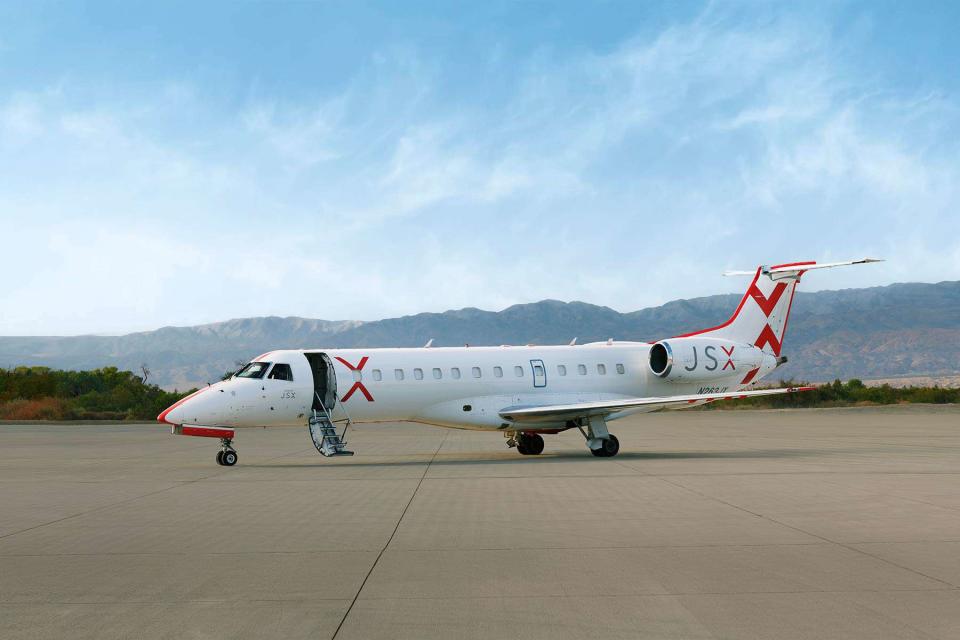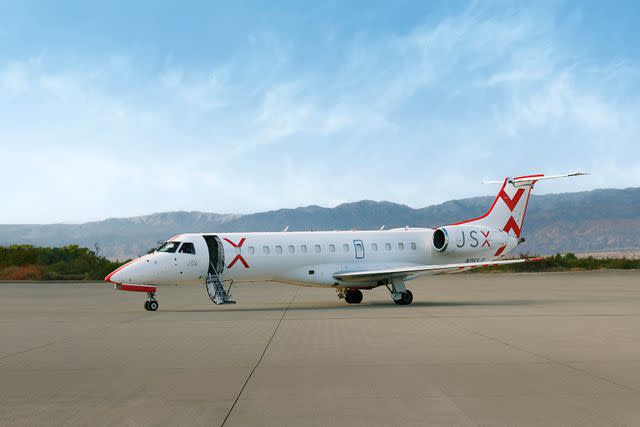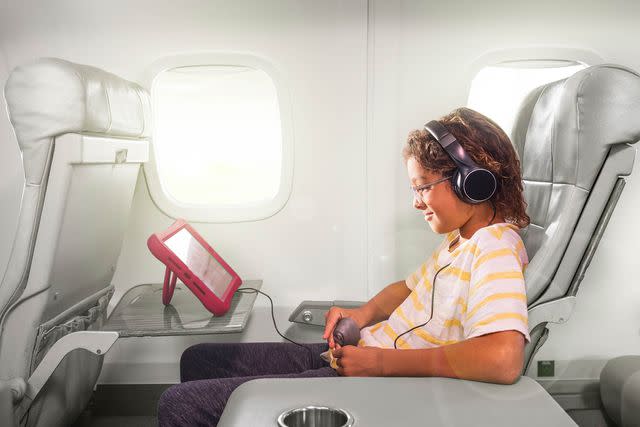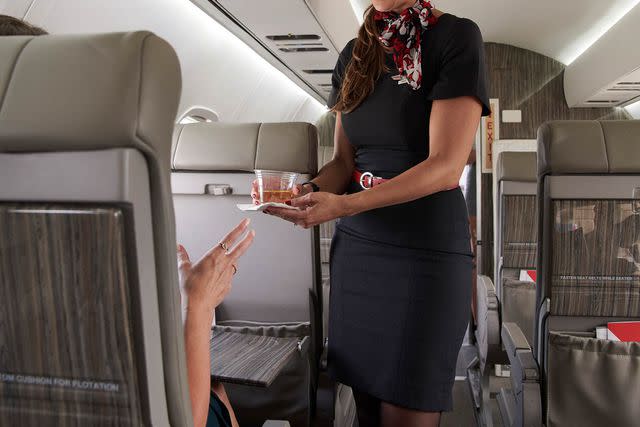This Semi-private Jet Company Has Flights at Commercial Prices — and Just Added In-flight Cocktail Hour, New Routes, and Super-fast Wi-Fi
JSX is having a huge year — with new international routes and game-changing amenities.

Courtesy of JSX
By its very nature, flying private (or semi-private) eliminates much of the friction of traditional air travel. Forget arriving at the airport early, navigating TSA security, or even waiting at the baggage carousel. For JSX, the buzzy public charter company that primarily operates out of private jet terminals, the time savings and convenience for passengers can be immense.
“Our goal is simple: to have our customers be happier when they arrive than when they left,” says JSX CEO and founder Alex Wilcox at the company’s first-ever media day event. All of that convenience naturally comes at a price premium. Typically, a seat on a JSX flight hovers around what a first-class seat may cost on a commercial airline.

Courtesy of JSX
The Dallas-based carrier has had somewhat of a cult following since its inception in 2016, but this year is a particularly pivotal one. Growth is a key part of the plan, especially serving “smaller air markets that commercial just can’t do,” Wilcox says. This winter, the carrier expanded its coast-to-coast network to include international service, with seasonal flights to Cabo San Lucas from both Los Angeles and Dallas. In total, JSX now has 43 routes across 22 key North American markets.
The company is in the process of rolling out an in-flight feature that loyal JSX travelers have long had on their wish list: onboard Wi-Fi. Best of all, it's a blazingly fast service from SpaceX’s Starlink, an incremental leap over any other internet on board a plane today. Here’s what flying with JSX is like in 2023 — and what’s next for the company’s routes, facilities, and amenities.
Impressively Fast (and Free) Wi-Fi
A decade ago, the ability to stay connected at 35,000 feet felt like a privilege, not an expectation. Fast forward to 2023. JSX is not only (finally) installing gate-to-gate Wi-Fi on all aircraft, but it’s also the first carrier to use Starlink, an arm of Elon Musk’s SpaceX, with speeds faster than passengers may experience in their own home. (It's worth noting that Starlink is having a capital-m Moment right now; Cruise lines are rolling out Starlink Wi-Fi, and Delta is testing it out, too.)
Connectivity is seamless, with instant connection to the Starlink Wi-Fi network. There are no logins, landing pages, or sign-in procedures to contend with. Speeds are plenty fast, too, up to 100 megabytes — enough for anything from casual browsing to streaming, and yes, even for video conferencing like Zoom and FaceTime.
JSX executives say that it will be the first air carrier to get Federal Aviation Administration (FAA) approval for video calling on board. In a real-life test, I was able to video chat with someone else on board the aircraft, followed by a call to another person on the ground — all with no lag or latency. (The etiquette for doing such a thing in a confined space such as a plane will have to be discussed in a separate piece.)

Courtesy of JSX
Currently, all 21 of JSX’s E-145 aircraft are Starlink equipped, with the remaining 16 E-135 aircraft expected to have Wi-Fi installed by the end of May.
What’s Next for JSX?
New Routes: Going East
With two-thirds of the U.S. population east of the Mississippi, Wilcox and team say that East Coast flying is an untapped opportunity for JSX. White Plains, New York, is currently JSX’s Northeast base, and the only route the carrier currently offers is a daily service to Miami. This summer, expect Portland, Maine, and Martha’s Vineyard, Massachusetts, to get added to the map.
“Not only are some of the major airlines leaving behind smaller airports, but we’re also in the unique position to fly to places that they never would have access to,” Wilcox tells Travel + Leisure. Because of JSX’s status as a public air charter, the carrier has the ability to fly to three times the number of airports compared to a commercial airline. “Burbank to Concord was our first-ever route, and we need more of those types of secondary routes in our network.”
More Planes: It’s Called “Planecycling”
To grow rapidly, JSX needs planes. To that end, Wilcox says that a refreshed aircraft will enter JSX’s fleet every six weeks in 2023. The air carrier currently has 77 30-seat Embraer jets in its fleet — though only 37 of those planes are flying right now.
The company’s strategy is “planecycling": refreshing jets that would otherwise be parted out or discarded as waste, with ample usable life left on them. On board a test flight, the JSX cabin felt remarkably fresh, considering this was a 21-year-old Embraer E-145 jet. Cabins are particularly airy thanks to the removal of overhead bins and the addition of bright, modernized lighting. Power is at every seat along with the aforementioned free Starlink high-speed internet.
Refreshed Amenities and Facilities
On board, JSX recently introduced a new service concept, one that is particularly impressive for “long-haul” flights (over 550 miles). For these lengthier flights, the service flow includes a “cocktail hour,” hot towels, a cold meal service, a pass of the gourmet snack basket, and a “fresh farewell” mint. The flight attendant also offers water to the cabin every 15 minutes.

Courtesy of JSX
Revamped cold meal options include a Mediterranean-inspired chicken wrap, thai noodles, and a fruit and yogurt parfait. On the drink front, travelers can choose from a selection of rotating beverages, including this quarter’s options: an Ohza canned peach bellini and a cabernet sauvignon from California winery Murphy Goode.
Meanwhile, at the airport, JSX is in the process of building a new hangar in Dallas, functioning as both office space and a passenger terminal. Expect the fresh digs to open fully later this fall.
Chris is a Los Angeles-based travel writer with a focus on timely travel trends, points and miles, hot new hotels, and all things that go (he's a proud AvGeek and transit nerd). Formerly at The Points Guy, his work can now be found at Travel + Leisure, The Washington Post, Insider, and Lonely Planet, among others. Follow his travels on Instagram and Twitter.
For more Travel & Leisure news, make sure to sign up for our newsletter!
Read the original article on Travel & Leisure.

